
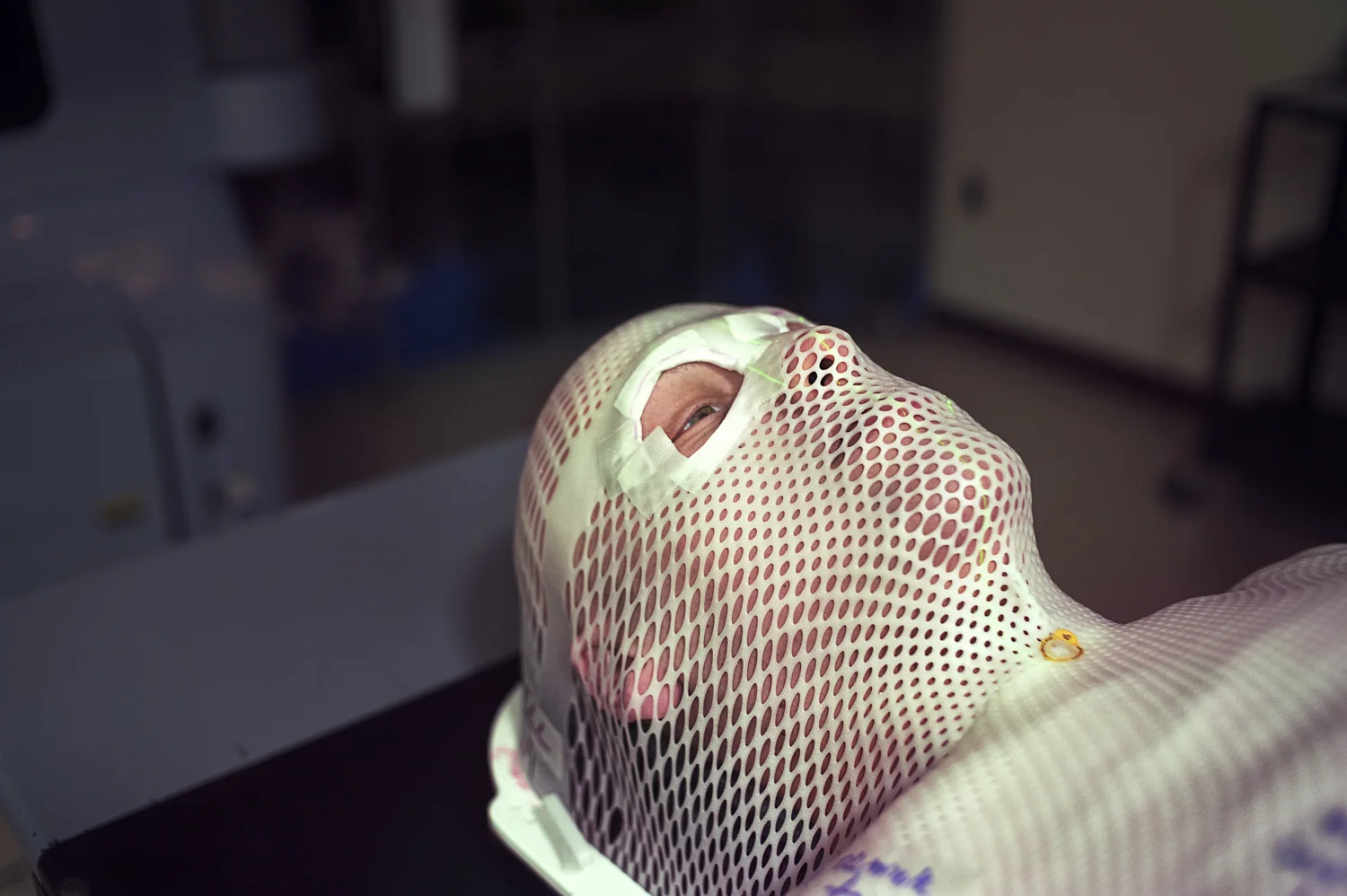
Mitch, preparing to undergo one of his radiation treatments. The "noninvasive mask" is custom fitted to Mitch's head in order to keep his head completely still while he is being treated. The holes allow for easier breathing, and is thought to help ease anxiety.
Mitch, diagnosed at age 20, was required to undergo approximately 19 alternating weeks of radiation treatment combined with chemotherapy in order to make the possibility of his ailment recede. Mitch suffered from Ewing's Sarcoma, a rare form of malignant bone cancer which predominantly effects teenagers and children, and becomes both increasingly uncommon in post teenage years and much more difficult to cure as patients get older.
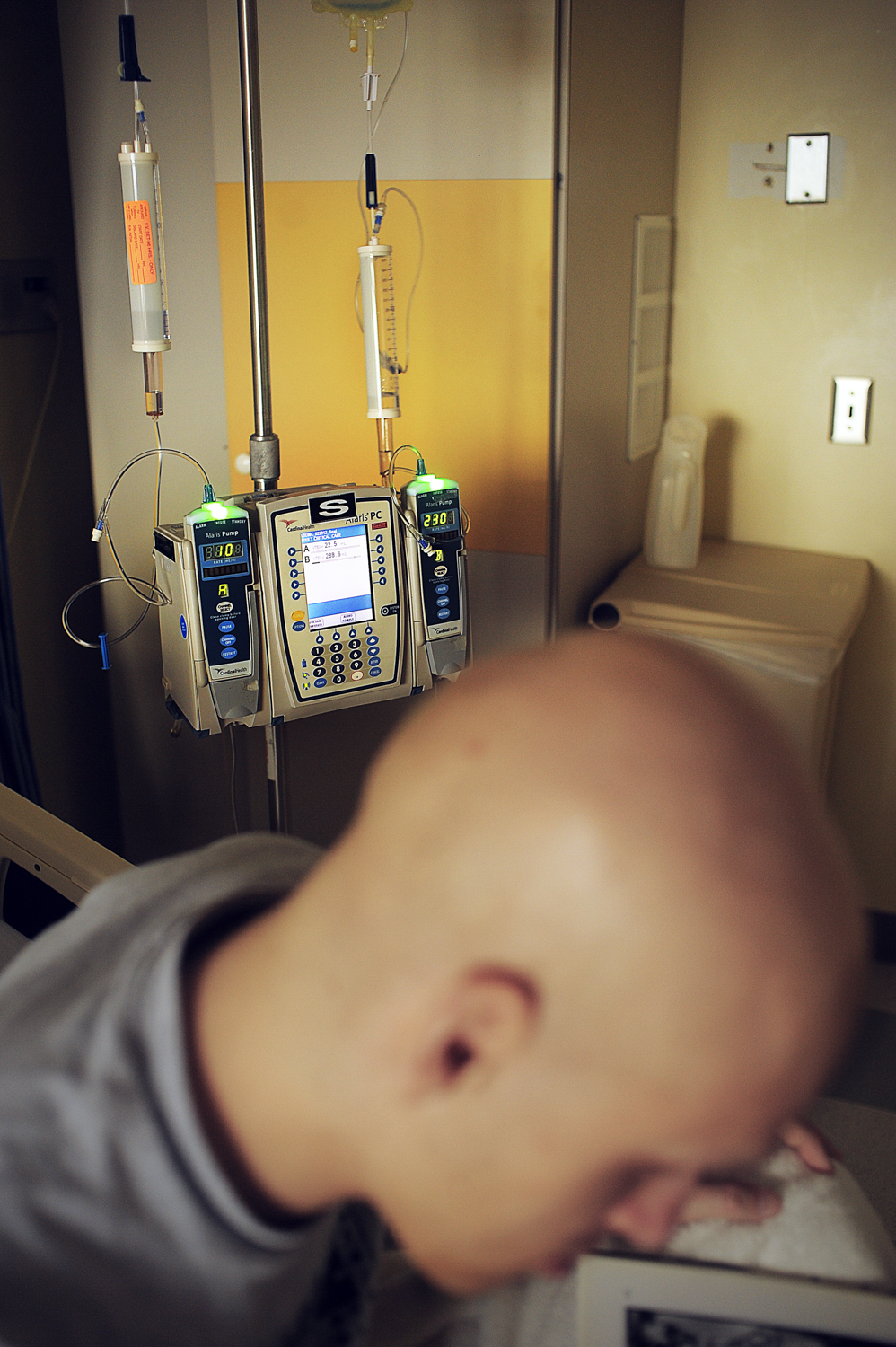
Mitch, diagnosed at age 20, was required to undergo approximately 19 alternating weeks of radiation treatment combined with chemotherapy in order to make the possibility of his ailment recede. Mitch suffered from Ewing's Sarcoma, a rare form of malignant bone cancer which predominantly effects teenagers and children, and becomes both increasingly uncommon in post teenage years and much more difficult to cure as patients get older.


In order for Mitch to be allowed for admittance into the hospital, he is required to administer medication during the weeks that he is home. He is given several types of medication to manage his pain, anxiety, and nausea.
Mitch, diagnosed at age 20, was required to undergo approximately 19 alternating weeks of radiation treatment combined with chemotherapy in order to make the possibility of his ailment recede. Mitch suffered from Ewing's Sarcoma, a rare form of malignant bone cancer which predominantly effects teenagers and children, and becomes both increasingly uncommon in post teenage years and much more difficult to cure as patients get older.

Mitch vomits from the combination of his medication and what little food he is able to eat.
Mitch, diagnosed at age 20, was required to undergo approximately 19 alternating weeks of radiation treatment combined with chemotherapy in order to make the possibility of his ailment recede. Mitch suffered from Ewing's Sarcoma, a rare form of malignant bone cancer which predominantly effects teenagers and children, and becomes both increasingly uncommon in post teenage years and much more difficult to cure as patients get older.

Mitch utilizes marijuana in order to ease the nausea from his chemotherapy and other medications.
Mitch, diagnosed at age 20, was required to undergo approximately 19 alternating weeks of radiation treatment combined with chemotherapy in order to make the possibility of his ailment recede. Mitch suffered from Ewing's Sarcoma, a rare form of malignant bone cancer which predominantly effects teenagers and children, and becomes both increasingly uncommon in post teenage years and much more difficult to cure as patients get older.
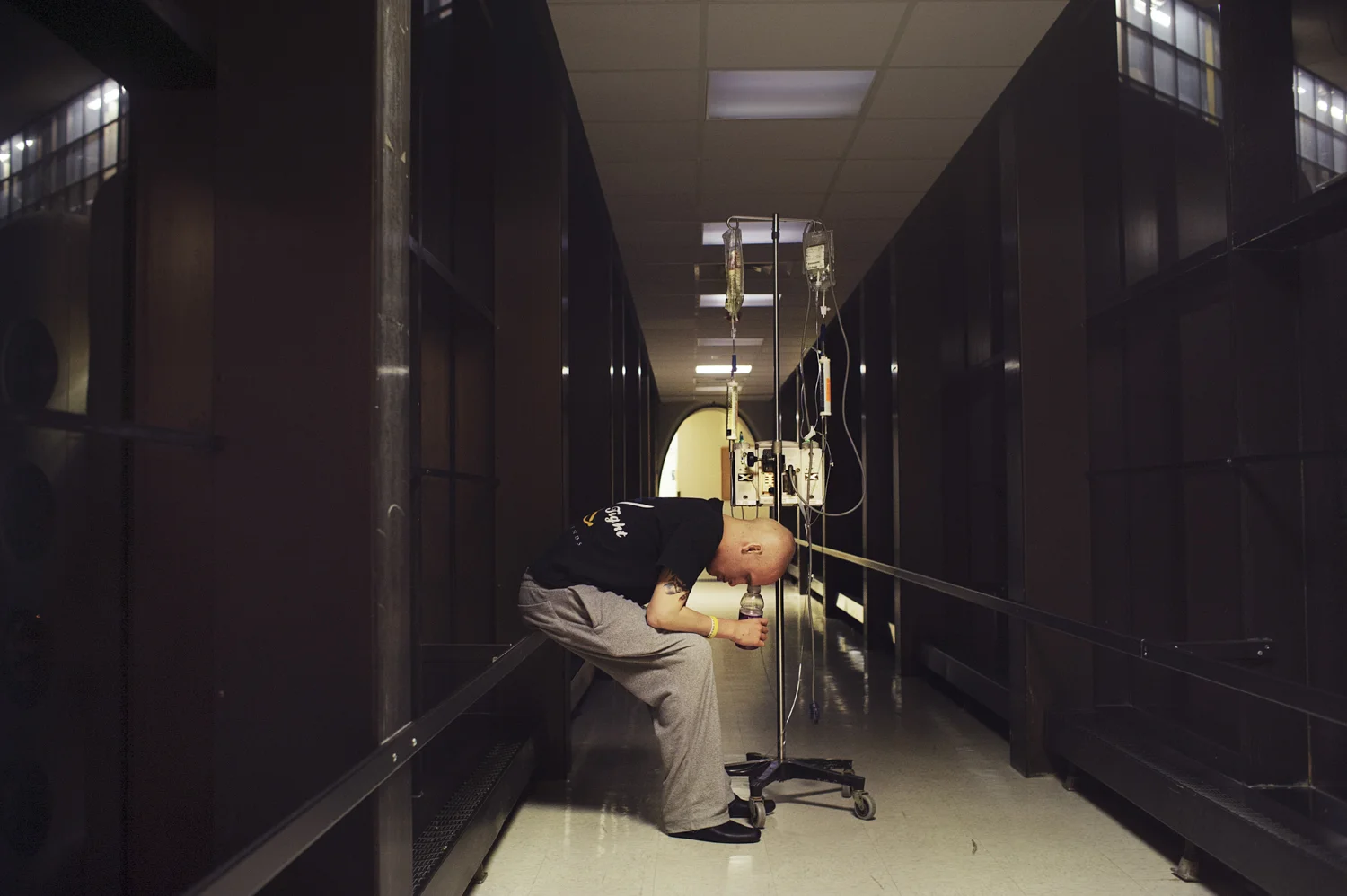
Mitch rests at a skybridge at Stony Brook University Medical Center. His Ewing's Sarcoma had metastasized from his clavicle into his abdomen and skull.
Mitch, diagnosed at age 20, was required to undergo approximately 19 alternating weeks of radiation treatment combined with chemotherapy in order to make the possibility of his ailment recede. Mitch suffered from Ewing's Sarcoma, a rare form of malignant bone cancer which predominantly effects teenagers and children, and becomes both increasingly uncommon in post teenage years and much more difficult to cure as patients get older.

Mitch, self portrait inside of his hospital room at Stony Brook.
Mitch, diagnosed at age 20, was required to undergo approximately 19 alternating weeks of radiation treatment combined with chemotherapy in order to make the possibility of his ailment recede. Mitch suffered from Ewing's Sarcoma, a rare form of malignant bone cancer which predominantly effects teenagers and children, and becomes both increasingly uncommon in post teenage years and much more difficult to cure as patients get older.

Mitch is often seeking to be given pain medication before the dosage schedule even calls for it, sometimes being in so much pain that he can barely stand and asks for it hours beforehand.
Mitch, diagnosed at age 20, was required to undergo approximately 19 alternating weeks of radiation treatment combined with chemotherapy in order to make the possibility of his ailment recede. Mitch suffered from Ewing's Sarcoma, a rare form of malignant bone cancer which predominantly effects teenagers and children, and becomes both increasingly uncommon in post teenage years and much more difficult to cure as patients get older.

Mitch on the phone with his mother during one of his week long stays at the hospital, where he undergoes daily radiation treatment.
Mitch, diagnosed at age 20, was required to undergo approximately 19 alternating weeks of radiation treatment combined with chemotherapy in order to make the possibility of his ailment recede. Mitch suffered from Ewing's Sarcoma, a rare form of malignant bone cancer which predominantly effects teenagers and children, and becomes both increasingly uncommon in post teenage years and much more difficult to cure as patients get older.
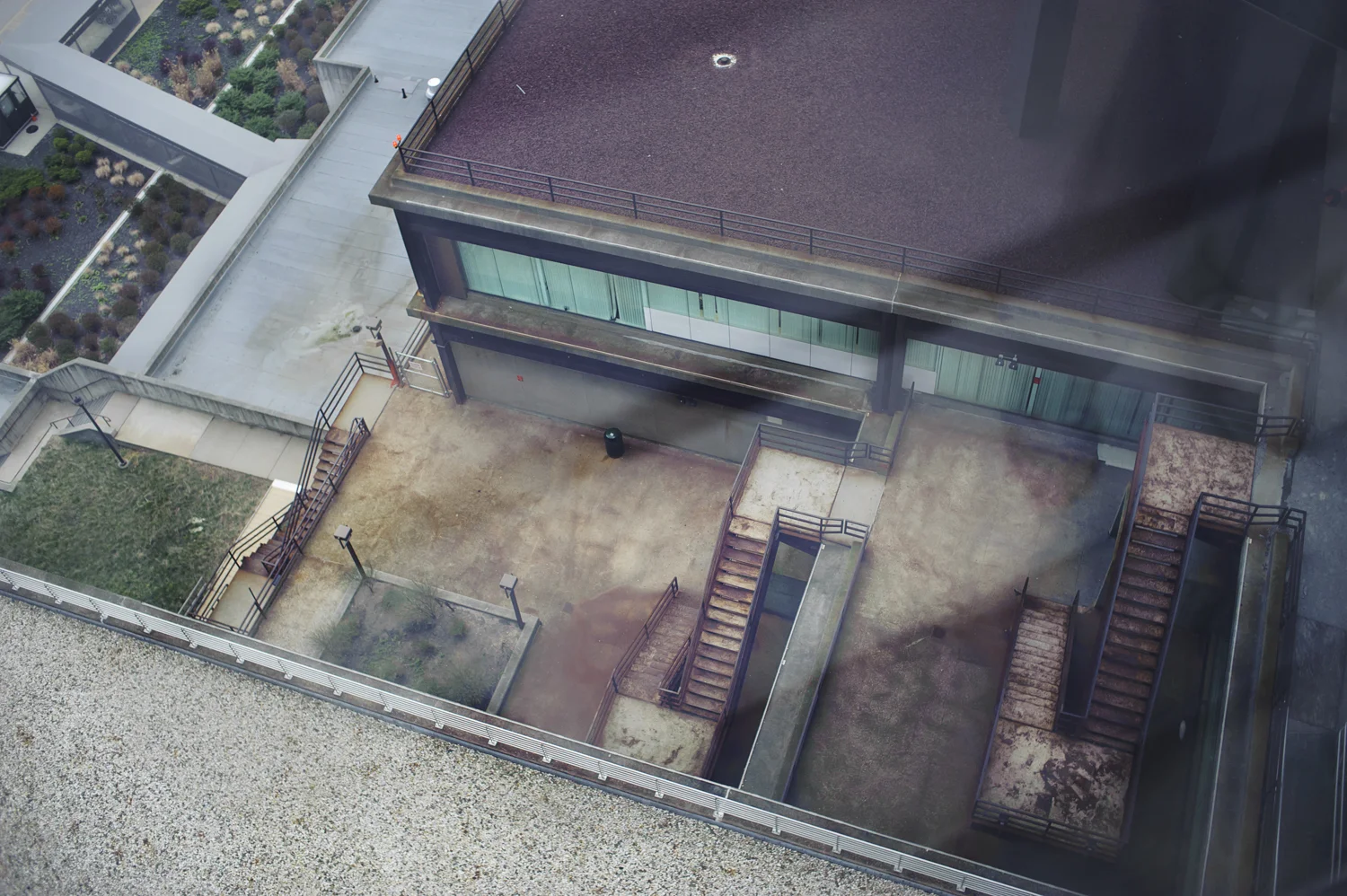
The view from a skybridge near Mitch's room at Stony Brook University Medical Center. Mitch, diagnosed at age 20, was required to undergo approximately 19 alternating weeks of radiation treatment combined with chemotherapy in order to make the possibility of his ailment recede. Mitch suffered from Ewing's Sarcoma, a rare form of malignant bone cancer which predominantly effects teenagers and children, and becomes both increasingly uncommon in post teenage years and much more difficult to cure as patients get older.
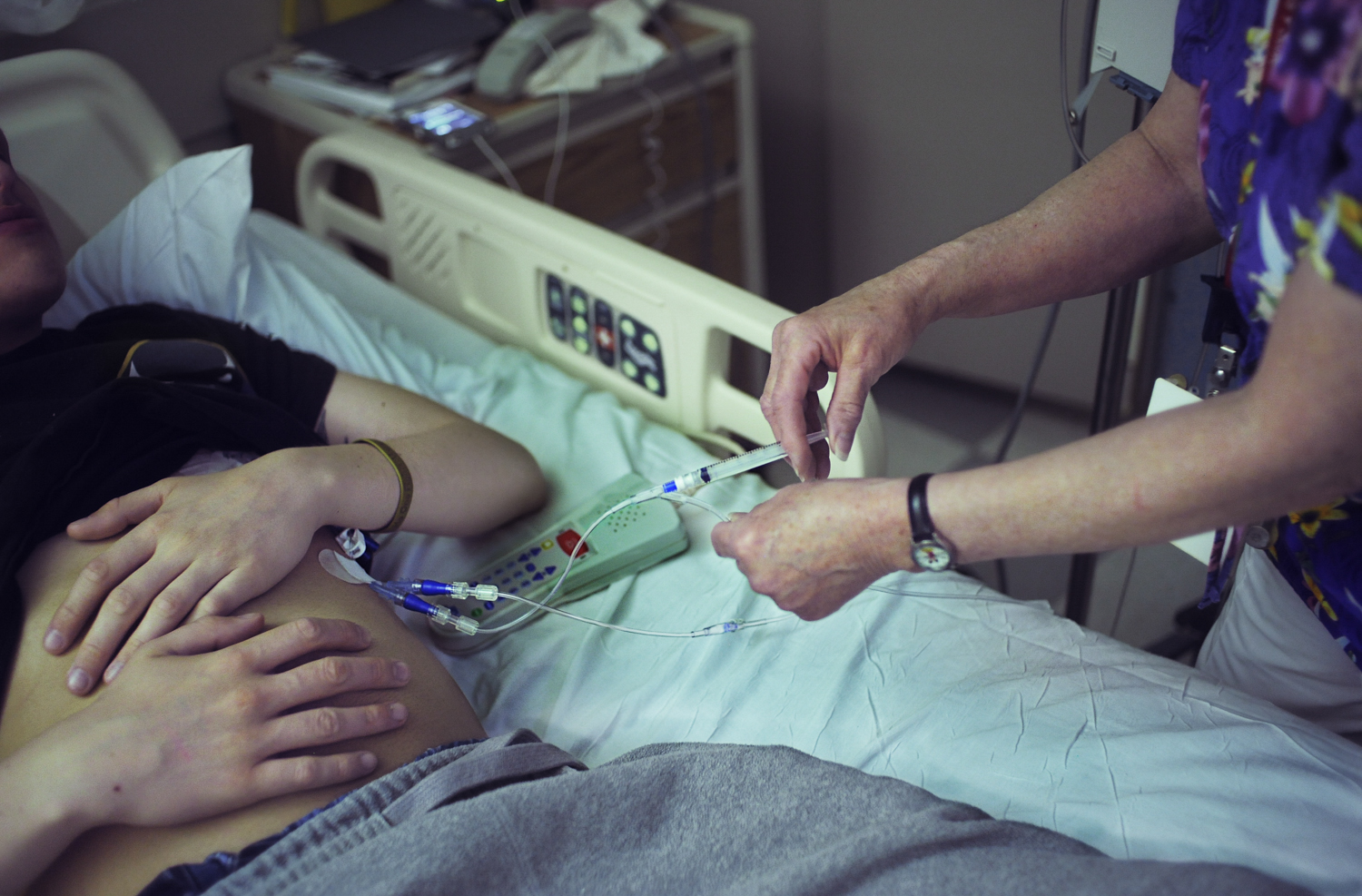
Mitch had planned to enroll into college once his treatments were complete, and had even took steps to enroll into online classes for journalism during the beginning of his weekly visits.
Mitch, diagnosed at age 20, was required to undergo approximately 19 alternating weeks of radiation treatment combined with chemotherapy in order to make the possibility of his ailment recede. Mitch suffered from Ewing's Sarcoma, a rare form of malignant bone cancer which predominantly effects teenagers and children, and becomes both increasingly uncommon in post teenage years and much more difficult to cure as patients get older.

The headboard and wall behind Mitch's bed.
Mitch, diagnosed at age 20, was required to undergo approximately 19 alternating weeks of radiation treatment combined with chemotherapy in order to make the possibility of his ailment recede. Mitch suffered from Ewing's Sarcoma, a rare form of malignant bone cancer which predominantly effects teenagers and children, and becomes both increasingly uncommon in post teenage years and much more difficult to cure as patients get older.

The pain and discomfort often kept Mitch from any sort of worthwhile sleep, and would take any sort of respite when he could get it.
Mitch, diagnosed at age 20, was required to undergo approximately 19 alternating weeks of radiation treatment combined with chemotherapy in order to make the possibility of his ailment recede. Mitch suffered from Ewing's Sarcoma, a rare form of malignant bone cancer which predominantly effects teenagers and children, and becomes both increasingly uncommon in post teenage years and much more difficult to cure as patients get older.

The aftermath of one of Mitch's's radiation treatments leaves indentations from his required mask as heat billows from the radiation treatment itself. He described it as a severe form of sun burning.
Mitch, diagnosed at age 20, was required to undergo approximately 19 alternating weeks of radiation treatment combined with chemotherapy in order to make the possibility of his ailment recede. Mitch suffered from Ewing's Sarcoma, a rare form of malignant bone cancer which predominantly effects teenagers and children, and becomes both increasingly uncommon in post teenage years and much more difficult to cure as patients get older.

Mitch sits in his bed at Stony Brook University Medical Center.
Mitch, diagnosed at age 20, was required to undergo approximately 19 alternating weeks of radiation treatment combined with chemotherapy in order to make the possibility of his ailment recede. Mitch suffered from Ewing's Sarcoma, a rare form of malignant bone cancer which predominantly effects teenagers and children, and becomes both increasingly uncommon in post teenage years and much more difficult to cure as patients get older.

There are three primary treatments of Ewing's Sarcoma, that are generally used in a combination: Surgery, Chemotherapy, and Radiation. The process can last for upwards of a year or more. After finishing treatment, patients will require follow up care. Outpatient hospital visits will be needed on a regular basis for the first few years after treatment and yearly after that.
Mitch, diagnosed at age 20, was required to undergo approximately 19 alternating weeks of radiation treatment combined with chemotherapy in order to make the possibility of his ailment recede. Mitch suffered from Ewing's Sarcoma, a rare form of malignant bone cancer which predominantly effects teenagers and children, and becomes both increasingly uncommon in post teenage years and much more difficult to cure as patients get older.

Mitch sits in his bed at Stony Brook University Medical Center. Given that the tumor is most commonly found in teens and children, Mitch was often placed in the pediatric wing of the hospital.
Mitch succumbed to Ewing's Sarcoma on October 11, 2013 at the age of 22.
According to the Bone Cancer Research Trust, the overall 5-year survival rate for Ewing's sarcoma is around 60%. The term does not mean people only lived for 5 years after diagnosis; it refers to the fact that 60 out of every 100 people with Ewing's sarcoma are alive 5 years after their diagnosis.
Mitch, 20, was required to undergo approximately 19 alternating weeks of radiation treatment combined with chemotherapy in order to make the possibility of his ailment recede. Mitch suffered from Ewing's Sarcoma, a rare form of malignant bone cancer which predominantly effects teenagers and children, and becomes both increasingly uncommon in post teenage years and much more difficult to cure as patients get older.
19 Weeks



















